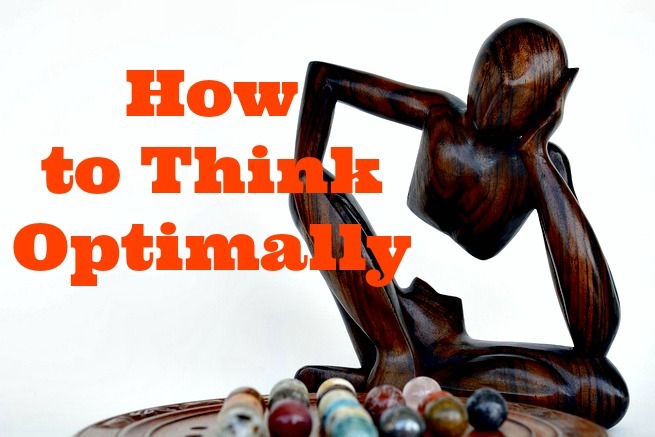
Thinking optimally will allow you to achieve your best results.
Being a positive thinker is often equated with being confident and assured, thinking in terms of success, and believing that you deserve the best that life has to offer. And, of course, these are all good things.
 However, positive thinking can lead you astray. Here are some of the traps you could fall into if you’re always thinking positively:
However, positive thinking can lead you astray. Here are some of the traps you could fall into if you’re always thinking positively:
- Disregarding the old adage that if something seems too good to be true, it probably is. This can lead you to fall victim to scams, such as investing your hard-earned money in get-rich-schemes.
- Jumping into situations without taking the necessary time to weigh the risks and prepare adequately
- Failing to anticipate likely obstacles.
- Failing to prepare a contingency plan in case something goes wrong.
- Hoping that an unfavorable situation will rectify itself, instead of taking the necessary action to make things right yourself.
- Continue investing your time, money, and energy into a project when all the facts show that there’s no way to salvage it.
- Ignoring negative information which should be taken into account in order to get an accurate picture of the situation that you’re facing.
So, what’s the answer? Certainly not negative thinking. There are countless problems with negative thinking. Here are some of them:
- Negative thinkers are constantly missing out on opportunities because their attention is focused on all the things that could go wrong.
- Instead of coming up with ways to get things done, negative thinkers enumerate all of the reasons why this or that can’t be done.
- Negative thinkers anticipate failure, and they have a tendency to see their life as a series of problems.
The answer, then, is not to think positively or negatively. Instead, you should think optimally. What is optimal thinking? It’s a term coined by Rosalene Glickman in her book, Optimal Thinking: How to Be Your Best Self.
Optimal thinking will allow you to make the most constructive choice at any given moment, and to take the best actions to accomplish your highest priorities. Below you’ll discover how to think optimally.
What is Optimal Thinking?
Optimal thinking is focusing on the best or most constructive thought at all times. Optimal thinkers have realistic expectations and focus on optimizing situations within their control. It’s about constantly choosing your best option in any given moment. Optimal thinkers do the following:
- They embrace reality and ask: “What’s the best thing I can do under these circumstances?
- They take the worst-case scenario into account and ask themselves how they can minimize the risk and reduce the cost to themselves if things go wrong.
- When faced with a problem they ask themselves: “What’s the problem?”; “What are my options for resolving this?”; and “Among my options, which one will be the most beneficial?”
Three Ways of Thinking
Suppose that you have three friends and their names are Bob, Sue, and Ellen. They’ve all invested in the stock market. In addition, suppose that there’s been a lot of bad news about the stock market lately.
Bob is a negative thinker, Sue is a positive thinker, and Ellen is an optimal thinker. Here’s how each one would react to the fact that the stock market is dropping:
- Bob (negative thinker): “Of course the stock market is going to come crashing down, now that I’ve decided to invest in it. Things can only get worse. I better get all of my money out as soon as possible and salvage whatever I can.”
- Sue (positive thinker): “Well, I’m just going to leave my money where it is and trust that everything will turn out well in the end. If I think positively, everything will fall into place.”
- Ellen (optimal thinker): “Under these circumstances, is it better to take my money out of the stock market in order to minimize my present losses, or do I stand to gain in the long run if I leave my money where it is?”
Of the three, Ellen’s line of thinking is clearly the one that is most likely to lead to optimal results.
Making Optimal Decisions
Here’s another example: your employer goes out of business and you suddenly find yourself unemployed. Once again, the three possible scenarios are the following:
- Negative Thinking: “I’m going to become a bag lady and end up living in a box outside of Macy’s”.
- Positive Thinking: “Everything is going to be OK. I have enough money to cover my current expenses for the next six months, and I’m sure that I’m going to have found another job by then.”
- Optimal Thinking: “What expenses can I cut right away and how do I need to modify my lifestyle so that I can stretch out my savings for as long as possible? Can I create an additional source of income to make sure that I’ll be OK?”
Once you’re thinking optimally, follow the process that Glickman recommends in order to optimize your decisions. Here are the steps:
- Define the problem.
- Define the time frame in which the decision needs to be made.
- Make a list of all your possible options.
- Eliminate any options that are unrealistic.
- Write down the advantages and disadvantages of each option (the “pros” and “cons”).
- For each option, rate each “pro” and “con”– where a “10” means that it’s important, and a “1” means that it’s not important at all.
- Score each option. For each option, add up all of the points for the “pros” and all the points for the “cons”. Subtract the total for the “cons” from the total for the “pros”, and that gives you the score for that option.
- Choose the option with the highest score.
Some More Optimal Action Steps You Can Take
Here are three more steps that Glickman suggests that you take in order to become an optimal thinker:
1. If You Feel Like a Victim. Whenever you feel that you’re being victimized by another person, ask yourself what you want from that person that you’re not giving to yourself. What actions can you take in order to start providing this for yourself?
2. Dealing With Criticism. Decide on the best way to deal with criticism. Write down your strategy for dealing with criticism and practice it the next time somebody criticizes you. This is your Criticism Optimal Response.
Keep refining it until you have a strategy in place which allows you to learn and grow from any criticism that you receive, without feeling bad about yourself or becoming discouraged from going after your goals.
3. Dealing With Fear. Whenever you begin to feel afraid ask yourself the following questions: “What am I afraid of?”; “What is the best way to overcome this fear?”; and “What action can I take to get over this fear, or to act in spite of this fear?”
Conclusion
I’m an optimist by nature, but when it comes to making decisions I always try to do so by thinking optimally. I recommend that you follow Glickman’s advice and do the same.
To recap, when assessing any situation, you need to do the following:
- Take the good and the bad into account;
- Weigh both your strengths and your weaknesses;
- Ask yourself what’s the most constructive action that you can take given your current set of circumstances;
- Make the best choice given the facts; and
- Come up with a contingency plan in case things go wrong.
Life your best life by thinking optimally.





Related Posts:




 Marelisa Fabrega is a lawyer and entrepreneur. She holds a Bachelor of Science in Business Administration from Georgetown University in Washington, D.C., as well as a Juris Doctor from the Georgetown University Law Center. You can learn more about her
Marelisa Fabrega is a lawyer and entrepreneur. She holds a Bachelor of Science in Business Administration from Georgetown University in Washington, D.C., as well as a Juris Doctor from the Georgetown University Law Center. You can learn more about her 





